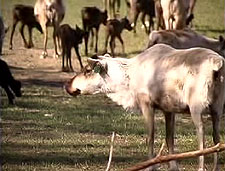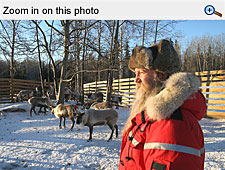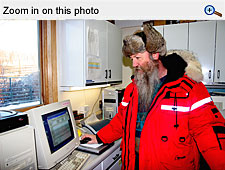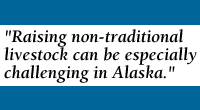Raising reindeer

Milan Shipka talks about the importance of reindeer to the economy of Alaska.
Video broadband (5.6MB)
Video dialup (1.7MB)

Milan Shipka looks over the female reindeer involved in his study of reindeer gestation
at the UAF Large Animal Research Station.

Milan Shipka, UAF Cooperative Extension Service livestock specialist and associate
professor in the Department of Plant, Animal and Soil Science, reviews data collected
from radio transmitters attached to female reindeer in his study of reindeer gestation
at UAF's Large Animal Research Station in Fairbanks.
By Debra Damron, Cooperative Extension Service
Milan Shipka is a livestock specialist with the University of Alaska Fairbanks Cooperative Extension Service. "My work in reindeer research involves studying and understanding hormonal changes associated with the estrous cycle, pregnancy and the non-breeding season in reindeer cows and bulls," Shipka said. "My research group and I relate these pieces of information to changes in other physiologic parameters such as body weight, antler development, gestation length, milk production and calf survival and growth."
 Shipka travels throughout the state to help both traditional and non-traditional animal
producers. He says raising non-traditional livestock can be especially challenging
in Alaska since so much is still to be learned about care and feeding the animals
in farming or ranching situations. One of Shipka's projects sheds new light on how
to manage herd size and reindeer health. Shipka and his team have been able to identify
the length of gestation in reindeer by knowing with precision when conception occurred.
Shipka travels throughout the state to help both traditional and non-traditional animal
producers. He says raising non-traditional livestock can be especially challenging
in Alaska since so much is still to be learned about care and feeding the animals
in farming or ranching situations. One of Shipka's projects sheds new light on how
to manage herd size and reindeer health. Shipka and his team have been able to identify
the length of gestation in reindeer by knowing with precision when conception occurred.
"This is important information for reindeer producers, especially people who keep reindeer behind fence. By having a good idea of gestation length, producers know when to be especially vigilant for newborn calves and perhaps improve calf crop success," he said.
Since global warming may affect newborn reindeer calves by raising temperatures in early spring, Shipka and his colleagues are investigating ways to start the breeding season earlier.
"We're also looking at potential ways to modify rut-associated aggressive behavior in bulls and ways to limit seasonal fertility in bulls without hindering future fertility," he said. "So far we haven't had any positive results. Rutting bulls are very difficult to handle, in fact they are downright mean and ornery. This problem requires more attention."
Exploring ways to control herd size and maintain healthy livestock has likely taken place since reindeer were first domesticated some five to seven thousand years ago in Scandinavia and Russia. Information gained from Shipka's research feeds directly into animal science extension workshops and classes on animal reproduction that he teaches around the state. In addition, Shipka takes his research information directly into the classroom in the animal science classes taught on the UAF campus in Fairbanks and at the Palmer Research and Extension Center.


